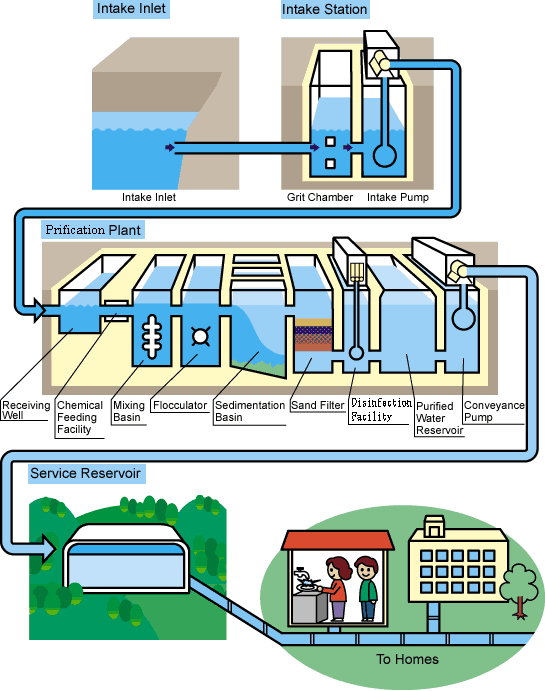|
|
|
|
 Water
that is safe to drink is called potable water, or drinking water, in
contrast to safe water, which can be
used for bathing or cleaning. In the United States, the Environmental
Protection Agency sets maximum levels for the 90 most commonly occurring
contaminants. If something happens to your water supply, your supplier
has to contact you to let you know what precautions you should take. Water
that is safe to drink is called potable water, or drinking water, in
contrast to safe water, which can be
used for bathing or cleaning. In the United States, the Environmental
Protection Agency sets maximum levels for the 90 most commonly occurring
contaminants. If something happens to your water supply, your supplier
has to contact you to let you know what precautions you should take.
Water treatment requires six basic steps.
-
In coagulation, coagulants like lime and
alum are added to the water, which causes particulates to clump
together.
-
Next, the water is shaken into larger
clumps, called flocs.
-
The sedimentation process requires that
the water stand for 24 hours, which allows the clumps to settle to
the bottom.
-
The water is then filtered, disinfected
(usually with chlorine) and aerated.
-
Aeration helps to remove certain
contaminants like radon.
Water Survival Techniques
If your water becomes contaminated and you don't have bottled water, you
can purify it in a few different ways. If it is cloudy, first filter it
through clean cloths or allow it to settle and then pour off the clear
water. Then, you can boil the water for one minute to kill most
disease-causing organisms.
You can also add one-eighth of a teaspoon of household chlorine bleach
per gallon of water (or follow directions on the label). You should
double the amount if the water is discolored or murky. Stir and let it
stand for 30 minutes. Chlorine bleach tablets are sold at camping supply
stores to purify water for drinking. You can also use five drops of
iodine per gallon to disinfect water.
Store boiled or disinfected water in clean, covered containers. If the
boiled water tastes too flat or the chlorine taste is too strong, pour
it from one container into another.

Source: http://science.howstuffworks.com |
|


 Water
that is safe to drink is called potable water, or drinking water, in
contrast to safe water, which can be
used for bathing or cleaning. In the United States, the Environmental
Protection Agency sets maximum levels for the 90 most commonly occurring
contaminants. If something happens to your water supply, your supplier
has to contact you to let you know what precautions you should take.
Water
that is safe to drink is called potable water, or drinking water, in
contrast to safe water, which can be
used for bathing or cleaning. In the United States, the Environmental
Protection Agency sets maximum levels for the 90 most commonly occurring
contaminants. If something happens to your water supply, your supplier
has to contact you to let you know what precautions you should take.